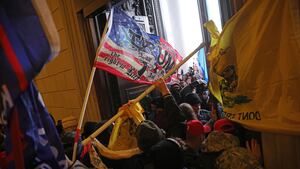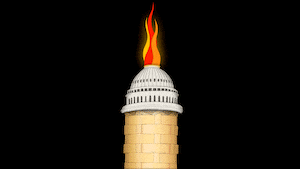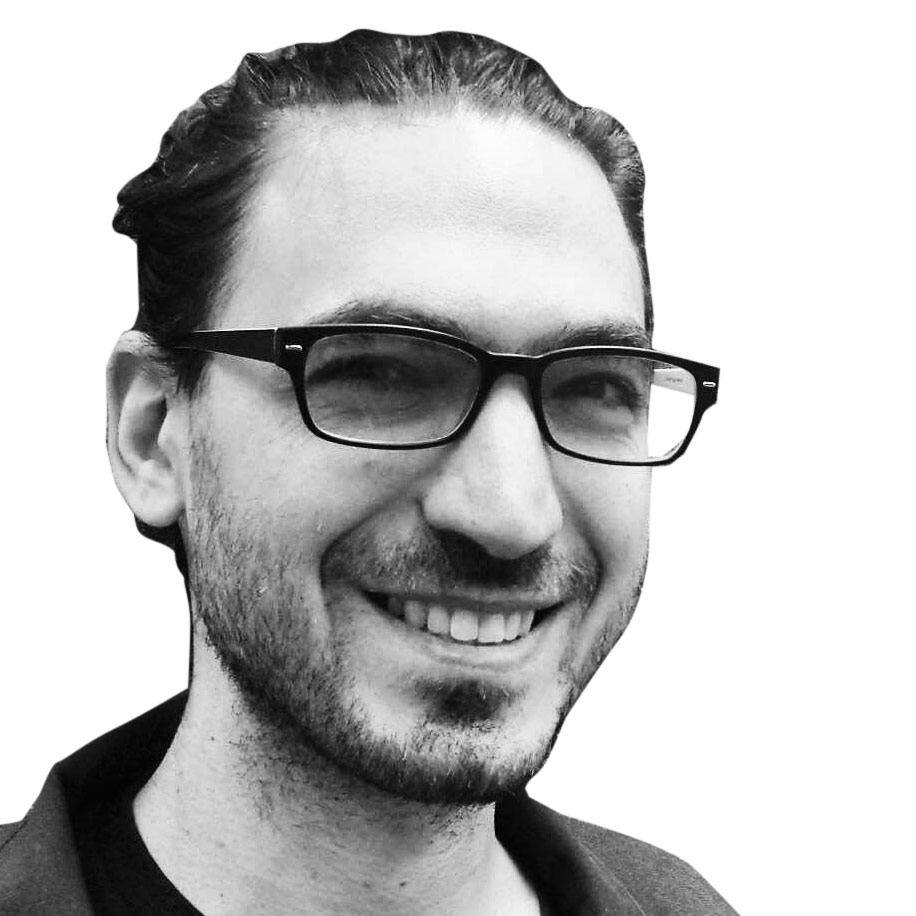When the insurrectionists stormed the Capitol, I was sitting in my Brooklyn apartment in my pajamas, following live Twitter feeds. At some point I started getting messages that someone was accusing me of being a prominent QAnon activist who’d been photographed at the riot. As someone who’s written about the far right for years and had been the subject of their conspiracy theories before, I shrugged it off.
Then I started getting more messages. This time from old friends—classmates from college, even ex-girlfriends—to see if I was OK. It slowly dawned on me that the tweeter was not a run-of-the-mill unhinged person but a famous unhinged person: Trumpist attorney Lin Wood, who worked on the Kraken lawsuit and had over a million followers. Threats naturally followed, and Wood’s tweet was reported in The New York Times as part of a story debunking the false claims that antifa had secretly stoked the right-wing violence.
Wood’s Twitter was quickly suspended, but not before the post had, at least the last time I took a screenshot, 28,000 retweets and 47,000 likes. For days, right-wing social media and blogs have, repeating Wood’s claim, declared that I am actually the QAnon activist Jake Angeli. Nicknamed “Q Shaman,” he is known for his distinctive outfit—including Halloween-ey plastic horns and face paint—and high-octane rants against a supposedly satanic, pedophilic “deep state.” Angeli has arm and chest tattoos, while I have none, and he’s more than a decade younger than me, as evidenced by comparing my bulging middle-aged midsection to his muscular physique. While Angeli, who was arrested on Saturday, had loudly complained that he was being smeared as “antifa,” rather than getting his due as a Q stalwart who took the dais in victory, none of that was enough to staunch the talk about my supposed role in this conspiracy.
The broader conspiracy about antifa somehow being behind the violence quickly spread, with Rep. Matt Gaetz (R-FL) even repeating it on the House floor when lawmakers returned there on the evening of the invasion. (The FBI later debunked the claim.) And although the secret antifa provocateurs were usually unnamed, insofar as they were named I appeared to be the main culprit.
So how did I come to be the face—or, rather, the name behind somebody else’s face—of a right-wing campaign to deny crimes committed by other right-wingers? What unfolds is a decade-long tale of an ever-morphing conspiracy theory about me, originally forged in the crucible of neo-Nazi anti-Semitism and developed by a variety of small-time far-right figures before a Trumpist grifter injected it onto a national stage. And it’s also a story about how purely anti-Semitic conspiracies get toned down and then circulated more broadly, while retaining the same storyline and targeting the same individuals.
As Richard Hofstadter wrote in his seminal essay “The Paranoid Style in American Politics,” conspiracy theories are often based in a kernel of truth. That kernel began for me with a talk I gave in 2010 on behalf of the now-infamous Rose City Antifa in Portland, Oregon. They had been struggling to expel several anti-Semites who were in left-wing spaces, including a well-known local progressive activist-turned-Holocaust denier. My talk outlined the contours of anti-Semitism and included examples of it being found on the left. Maybe 30 people attended, but it was recorded and put online.
Some fascists pay attention to the left, in hope of making alliances or cross-recruiting members, or simply to know and target their enemies. A New Yorker named Eric Striker—who, in one of the many ironies of this story, is apparently Latino—became obsessed with my talk. He called me an “influential Jew Antifa ideologue” on a 2015 Twitter thread in conversation with two key figures in the emerging alt-right: the Daily Stormer’s Andrew Anglin and “Ricky Vaughn.” (The latter’s Twitter account was found by an MIT election study to be more influential during the 2016 election than those of the Democratic Party or NBC News.)
It was a little ridiculous, but nothing compared to what was to come.
I had been getting other attention from the rapidly growing far right. Older racists like David Duke took swipes at me. My coverage of the Oregon militia movement in 2016 was widely attacked. On the webpage of the Three Percenters’ founder, one memorable comment called for me to be hung from a tree with ATF agents.
Another small-time New York far-right conspiracy theorist picked the story up, proclaiming on a podcast that I was the “leader of antifa.” But it was after the August 2017 “Unite the Right” rally in Charlottesville that the conspiracy was lit on fire. I was in the counter-demonstration and the car attack. Afterward the neo-Nazis and their sympathizers on 4chan and 8chan decided, perhaps egged on by Striker and the recent podcast, that I was the antifa leader. In fact, I soon became known as the “international leader of antifa”—since Jews are always thought of as international conspirators. (In fact, only part of my family is Jewish, but anti-Semites typically follow the “one drop of blood” rule.)
Death threats flooded my social media accounts, spreading to anyone I was affiliated with. I removed comments on my public Facebook, only to have fascists go after people who had “liked” my posts—forcing me to take the whole account down. There was a concerted effort on 4chan to dox me. Hours of Charlottesville footage was sorted through to find pictures of me standing around at different parts of the protest. Finally someone made a hit list of hundreds of “antifa” at Charlottesville. I was No. 3.
Needless to say, things were tense for a while. Living in New York City, legally carrying a gun was not an option. I was broke and strained to pay for things like cabs to limit my public exposure. (For a brief moment, cresting off the sudden popularity of the so-called alt-right, especially right around Charlottesville, there were about a half-dozen fascist groups in New York City.) I looked behind my back a lot. I made sure never to announce where I was going, and only did public talks with security guards present.
I foolishly went on assignment for Colorlines to cover another far-right rally the next month, the Mother of All Rallies in Washington, D.C. Since there was a dueling Juggalo rally at the same time, I thought that, between the police and the clown-faced anti-racists, there wouldn’t be a problem. I was wrong. The other rally was far away and no police were present. Another conspiracy theorist—who I call the Fraudster—saw me and started shouting that I was “antifa.” (The Fraudster did 10 years for a phishing scam and has filed hundreds of frivolous lawsuits.) This was revealing because it showed that he had been spending copious amounts of time in neo-Nazi discussion circles; he was taking their talking points about Jewish targets and laundering them into this own, seemingly non-Nazi, conspiracies. I was soon surrounded by a group of Proud Boys and would probably have been beaten had I lost my composure. (Compared to what happens at protests now, 2017 seems like halcyon days.) A video of this was put on YouTube.
Next, a frothing fascist named Daniel McMahon (who used aliases like Pale Horse and Jack Corbin) picked up the ball. He was sitting in his rich parents’ home in Florida and armed to the teeth; his own mother told authorities she was afraid her son might become a mass shooter. I had apparently gotten on his radar during the Oregon events, but now he became obsessed with me. Known for his prolific and wanton threats, he declared me his “#1 enemy.” Other comments included that I was “the most evil Jew in the USA,” “down right pure evil,” and that I was “a global Antifa leader. He is also a kike.” (One of my favorite comments on his posts was that my “eyes speak of an emptiness aside from a consuming hatred. Like a beast that needs to be put down.”)
It was sort of funny, except it wasn’t. In October 2018, Robert Bowers walked into Pittsburgh’s Tree of Life synagogue and murdered 11 worshipers. The social media account he interacted with the most was McMahon’s. Considering McMahon’s fixation on me, I’ve wondered if Bowers had considered assassinating me. Although much too little and much too late, McMahon was arrested in September 2019 for sending racist threats to a Black city council candidate in Charlottesville as well as stalking a woman in Florida. He eventually got three and a half years and is currently in prison. After his arrest, I mostly dropped off the fascist radar. This did not upset me.

Jacob Anthony Chansley, also known as Jake Angeli, of Arizona, inside the U.S. Capitol on Jan. 6
Mike Theiler/ReutersLeading up to the Capitol protest, rumors circulated on the far right, as they had several times before, that antifa boogeymen were going to infiltrate this protest disguised as MAGAs. In the week before, the Fraudster decided to recycle the footage he had taken of me before, telling people to watch out for me at the D.C. rally. A YouTube video of me at the 2017 event popped up from a small account; by its own description, it is a ban-violator on its ninth rendition. There were also a few tweets. I didn’t think much of this; it was just another conspiracy theorist desperately recycling the bottom scrapings of his content barrel.
But little sparks can start fires. According to the Fraudster, Wood “probably” took the (already false) claims from the Fraudster’s Facebook account. Wood used the claim I was going to be in D.C. undercover to finger me as the antifa double agent directing events. I don’t know why Wood backstabbed Angeli by claiming he was an antifa agent. Perhaps Wood thought Angeli’s horns were discrediting the Trumpists’ big moment in the spotlight.

There are two lessons here, about anti-Semitism and social media. The first is that ideas cooked up by neo-Nazis can get “washed out” by removing references to Jews directly or to obvious codewords, like “Zionist bankers” or “Rothschilds.” But the initial targets who are often Jewish (or labeled as such) are kept, and the whole storyline remains intact. So whereas Nazis and other anti-Semites hold that the “Jews control the left and undermine the virtuous nation,” now “antifa is manipulating protests to discredit the patriots trying to save the nation.” I doubt that very many of the thousands of Trumpists who think I’m Angeli are motivated by anti-Semitism. But once you see the development of the conspiracy theory about me, without the anti-Semitism I would never have become a cut-rate George Soros.
Second, the amazingly quick explosion of these narratives show how short the trip is from the margins to the mainstream for wild conspiracy claims. What is one day a neo-Nazi narrative can the next be something that you see on your aunt’s Facebook post. All it took was one deranged lawyer with a Twitter account to convince millions of people that some guy wearing pajamas in Brooklyn is the secret mastermind behind an unfolding national disgrace.
I’m a bit curious about what the next permutation of the conspiracy theory about me will bring. But to be honest, I’m a bit nervous, too.




